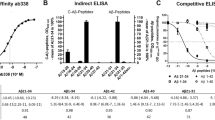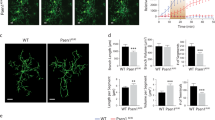Abstract
PROGRESSIVE cerebral deposition of the amyloid β-peptide is an early and invariant feature of Alzheimer's disease. The β-peptide is released by proteolytic cleavages from the β-amyloid precursor protein (βAPP)1, a membrane-spanning glycoprotein expressed in most mammalian cells. Normal secretion of βAPP involves a cleavage in the β-peptide region2-3, releasing the soluble extramembranous portion4,5 and retaining a 10K C-terminal fragment in the membrane6. Because this secretory pathway precludes β-amyloid formation, we searched for an alternative proteolytic processing pathway that can generate β-peptide-bearing fragments from full-length β APP. Incubation of living human endothelial cells with a βAPP antibody revealed reinternalization of mature βAPP from the cell surface and its targeting to endosomes/lysosomes. After cell-surface biotinylation, full-length biotinylated βAPP was recovered inside the cells. Purification of lysosomes directly demonstrated the presence of mature βAPP and an extensive array of β-peptide-containing proteolytic products. Our results define a second processing pathway for βAPP and suggest that it may be responsible for generating amyloid-bearing fragments in Alzheimer's disease.
This is a preview of subscription content, access via your institution
Access options
Subscribe to this journal
Receive 51 print issues and online access
$199.00 per year
only $3.90 per issue
Buy this article
- Purchase on SpringerLink
- Instant access to full article PDF
Prices may be subject to local taxes which are calculated during checkout
Similar content being viewed by others
References
Kang, J. et al. Nature 325, 733–736 (1987).
Esch, F. et al. Science 248, 1122–1124 (1990).
Sisodia, S. S., Koo, E. H., Beyreuther, K., Unterbeck, A. & Price, D. L. Science 248, 492–495 (1990).
Weidemann, A. et al. Cell 57, 115–126 (1989).
Oltersdorf, T. et al. J. biol. Chem. 265, 4492–4497 (1990).
Selkoe, D. J. et al. Proc. natn. Acad. Sci. U.S.A. 85, 7341–7345 (1988).
Chen, W. J., Goldstein, J. S. & Brown, M. S. J. biol. Chem. 265, 3116–3123 (1990).
Gimbrone, M. A., Cotran, R. S. & Folkman, J. J. Cell Biol. 60, 673–684 (1974).
Ponte, P. et al. Nature 331, 525–527 (1988).
Tanzi, R. E. et al. Nature 331, 528–530 (1988).
Kitaguchi, N., Takahashi, Y., Tokushima, Y., Shiojiri, S. & Ito, H. Nature 331, 530–532 (1988).
Haass, C., Hung, A. Y. & Selkoe, D. J. J. Neurosci. 11, 3783–3793 (1991).
Weibel, E. B. & Palade, M. D. J. Cell Biol. 23, 101–112 (1964).
Golde, T. et al. Science 255, 728–730 (1992).
Parton, R. G. et al. J. Cell Biol. 113, 261–274 (1991).
Tamaoka, A., Kalaria, R. N. Lieberburg, I. & Selkoe, D. J. Proc. natn. Acad. Sci. U.S.A. 89, 1345–1349 (1992).
Estus, S. et al. Science 255, 726–728 (1992).
Benowitz, L. I. et al. Expl. Neurology 106, 237–250 (1989).
Cole, G. M., Huynh, T. V. & Saitoh, T. Neurochem. Res. 10, 933–939 (1989).
Buktenica, S., Olenick, S. J. & Frankfater, A. J. biol. Chem. 262, 9469–9476 (1987).
Baskin, F., Rosenberg, R. G. & Greenberg, B. D. J. Neurosci. Res. 29, 127–132 (1991).
Goate, A. et al. Nature 349, 704–706 (1991).
Hunziker, W., Hartler, C., Matter, K. & Mellman, I. Cell 66, 907–920 (1991).
Lisanti, M. P., Sargiacomo, M., Graeve, L., Saltiel, A. R. & Rodriguez-Boulan, E. Proc. natn. Acad. Sci. U.S.A. 85, 9557–9561 (1988).
Storrie, B. & Madden, E. Meth. Enzym. 182, 203–210 (1990).
Dice, J. F. & Terlecky, S. P. Crit. Rev. Therap. Drug Carrier Systems 7, 211–233 (1990).
Author information
Authors and Affiliations
Rights and permissions
About this article
Cite this article
Haass, C., Koo, E., Mellon, A. et al. Targeting of cell-surface β-amyloid precursor protein to lysosomes: alternative processing into amyloid-bearing fragments. Nature 357, 500–503 (1992). https://doi.org/10.1038/357500a0
Received:
Accepted:
Issue Date:
DOI: https://doi.org/10.1038/357500a0
This article is cited by
-
ABCA7-Associated Clinical Features and Molecular Mechanisms in Alzheimer’s Disease
Molecular Neurobiology (2023)
-
Targeting isoaspartate-modified Aβ rescues behavioral deficits in transgenic mice with Alzheimer’s disease-like pathology
Alzheimer's Research & Therapy (2020)
-
Deciphering the neuroprotective and neurogenic potential of soluble amyloid precursor protein alpha (sAPPα)
Cellular and Molecular Life Sciences (2020)
-
Inhibitory activities of phenylpropanoids from Lycopus lucidus on amyloid aggregation related to Alzheimer’s disease and type 2 diabetes
Journal of Natural Medicines (2020)
-
Dopamine promotes cathepsin B-mediated amyloid precursor protein degradation by reactive oxygen species-sensitive mechanism in neuronal cell
Molecular and Cellular Biochemistry (2019)



